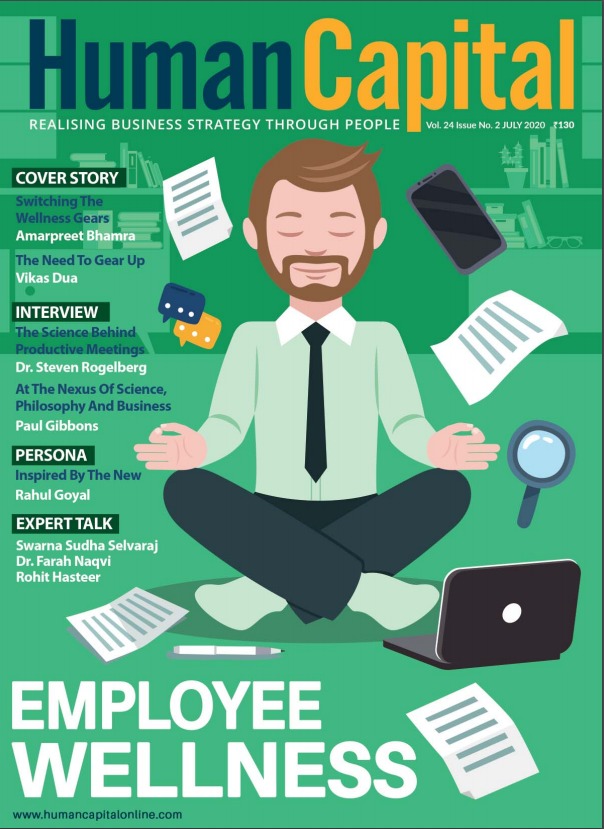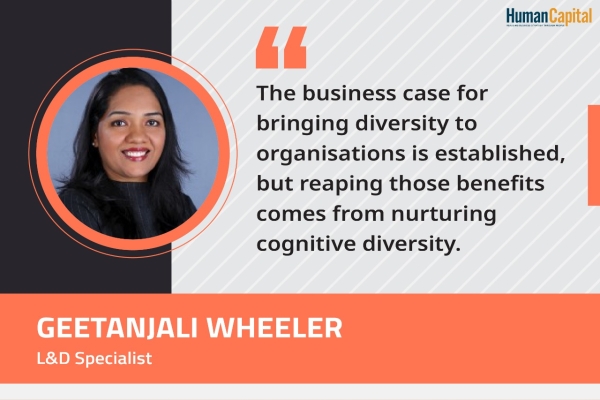Not only does Learning happen in the Training room, but it also takes place in the organisation's corridors.
Very often, participants returning from Classroom Training are asked about their experience by the Managers. Managers with higher expectations may even ask for a presentation or a session in which the participants can share their Learning with the rest of the team, which was not privileged enough to attend the Learning programme.
While the idea of Learning Organisation has been doing the rounds of corporate corridors for years now, few have embraced the reality that for learning to be a sustained experience and an advantage for the organisation, it needs to be systematic and not just restricted to the classroom or those logged into the e-session.
Every organisation that is serious about driving learning and innovation needs to ensure that the key learning is embedded into the organisational culture and is not something that is restricted to a few Training rooms. But then, how does one do that? Below are some of the necessary actions that need to be taken.
Leaders logged in
Tenured corporate warriors know that organisations are what Leaders do. Leaders have a disproportionate influence on the organisational culture. Hence, if a Learning culture is to be driven across the organisation, Leaders should not only be in the know about key Learning interventions in the organisation, but should be active in driving and reinforcing the message. When the rank and file hear the Leader discussing the programmes, a buy-in gets created and the awareness and keenness to participate multiplies.
On Job Learning
As HR Honchos are aware, the 70- 20-10 rule of Training is almost a truism now, but only as far as awareness is concerned. Implementing it is a different story altogether. The Learning being imparted by the L&D function needs to be structured in the workflow and key phrases and activities need to be consciously embedded in the work processes and also in the techniques adopted. One of the biggest examples comes from GE, where Six Sigma was embedded in every department and thereafter into the workflow of processes.
Roadshows Galore
When the L&D department is talking about values and practices that are needed to be imbibed, let every HoD become its Ambassador. Let every important decisionmaker in the company know and share their thoughts and actions on the topic.
Let us say, Innovation and Entrepreneurial spirit is what the company wants to build in its workforce. Then
• Let there be Roadshows on the topic
• Let it be a platform where every department can showcase its innovations
• Let there be an adrenalin rush of healthy competition to recognise the best innovations
In the late 1990s and early 2000, when IBM was changing course from a manufacturing giant to a services company, one tagline that formalised and recognised the transition was On Demand business. The entire company came together to complement the spirit of bespoke business; each department proudly transitioned to a mind-set of flexible, customised solutions.
Corridors have ears and mirrors too
Corridors are not just walkways, they are important spaces where key messages need to be reinforced. Often, one sees white walls in the corridors. More often than not, companies are focussed on revenue growth and healthy margins, but do not necessarily have a perspective on how to thrive in the longer term. Such companies which have a narrow focus on immediate financials often lose the plot quickly.
For the Learning organisation, it is important to confidently message its vision, values and key focus areas to all stakeholders. If the L&D programmes are aligned to the organisational competencies, they, in turn, are connected to key focus areas. They need to send the message across the length and breadth of the organisation so that they are constantly reinforced.
An undeclared underworld is an informal part of any organisation; evident in the water cooler talk, in the informal culture of the organisation and in the chit-chat doing the rounds of the corporate.
Performance Appraisals
At the heart of every employee’s performance lies the anticipation for a good appraisal. Every employee does all that she can do to ensure that Appraisals go well. What Managers focus on during the Appraisal discussion determines what the employee will focus on through the year. If there is a formal weightage given to Learning, then all employees will ensure the expectations are met and exceeded. So, that it is not a tick box activity, it is vital that the KRAs are clear and outcome-based, rather than being just vague recommendations.
The Formal Culture
It is common knowledge that while the Finance numbers are reviewed rigorously, often daily, leadership rarely reviews L&D programmes or their impact on the business. L&D needs to find a place in the review deck of the CEO, perhaps in the HR slides, but it must receive the CEO’s attention.
L&D Leaders too need to ensure the Pull Strategy works, by way of popularising their programmes, through regular mailers in internal communication and newsletters, and most importantly, embedding it in the overall Employee Development and Engagement strategy of the organisation. It was a similar perspective of a holistic approach, which resulted in the birth of the Balance Scorecard mechanism by Norton and Kaplan in the 1990s.
Side by side, every L&D department needs to know ways to advertise its offerings and their impact. It also needs to recognise its Ambassadors with Rewards and Recognition. For example, many companies recognise committed Learners with badges and plaques as Learner of the Month or Learner of the Year etc. and even create hierarchies of Learners to motivate and incentivise Learners.
The Soft Culture
Last, but not least, every organisation has an undeclared underworld. Do not get me wrong, it is not the dubious dark underworld of gangsters, but an informal part of any organisation, which is in evidence in the water cooler talk, in the informal culture of the organisation, in the chit-chat doing the rounds of the corporate. A litmus test of whether the focus on Learning has sunk in or not can be gauged from the attention it gets in these informal channels of communication. If the L&D programmes and initiatives get discussed, then one could say it is a moment of arrival of L&D in the organisation.
.jpg)
Does your organisation support you in maintaining work-life boundaries?
Trending
-
SBI General Insurance Launches Digital Health Campaign
-
CredR Rolls Out 'Life Happens' Leave For Its Employees
-
Meesho Announces 30-Week Gender-Neutral Parental Leave Policy
-
Microsoft Unveils Tech Resilience Curriculum To Foster An Inclusive Future
-
60% Indian Professionals Looking For Job Change Due To COVID: Survey
-
SpringPeople And Siemens Collaborate For Digital Transformation Push
-
86% Professionals Believe Hybrid Work Is Essential For Work Life Balance: Report
-
Almost 1 In Every 3 People's Personal Life Affected Due To Work Stress
-
Meesho Rolls Out Reset And Recharge Policy For Employees
-
80% Of Talent Leaders & Academics Say Pandemic Changed Skill Needs For Youth: Report
-
Hero Electric Rolls Out 'Hero Care' Program For Employees
-
Human Capital In Collaboration With ASSOCHAM Hosts Virtual Conference
-
IKEA India, Tata STRIVE Collaborate To Create Employability And Entrepreneurship Opportunities
-
SAP India, Microsoft Launch Tech Skilling Program for Young Women
-
DXC Technology, NASSCOM Collaborate For Employability Skills Program
-
Lenskart To Hire Over 2000 Employees Across India By 2022
-
Mindtree Launches Learn-and-Earn Program
-
Tata AIA Extends 'Raksha Ka Teeka' To Its Employees
-
Swadesh Behera Is The New CPO Of Titan
-
NetConnect Global Plans To Recruit 5000 Tech Professionals In India
-
Hubhopper Plans To Hire 60% Of Indian Podcasters By 2022
-
Corporate India Needs More Women In Leadership Roles: Report
-
Aon to Invest $30 Million and Create 10,000 Apprenticeships by 2030
-
Tech Mahindra Launches ‘Gift a Career’ Initiative for Upskilling of Youth
-
40% Women Prefer Flexible Working Options in Post-COVID World: Survey
-
3 out of 4 companies believe they can effectively hire employees virtually: Report
-
Vodafone , CGI and NASSCOM Foundation launch digital skills platform
-
Odisha: Bank, postal employees to deliver cash for elderly, differently-abled persons
-
Skill India launches AI-based digital platform for "Skilled Workforce"
-
Hiring activity declines 6.73% in first quarter: Survey
-
70% startups impacted by COVID-19 pandemic
-
Bajaj Allianz Life ropes in Santanu Banerjee as CHRO
-
Over 70 Percent MSMEs look at cutting jobs to sustain businesses
-
93 Per Cent employees stressed about returning to office post-lockdown
-
Johnson & Johnson India announces family benefits for same gender partners
-
Indian firms turning friendly towards working mothers
-
Welspun India names Rajendra Mehta as new CHRO
-
Wipro partners with NASSCOM to launch Future Skills platform



Human Capital is niche media organisation for HR and Corporate. Our aim is to create an outstanding user experience for all our clients, readers, employers and employees through inspiring, industry-leading content pieces in the form of case studies, analysis, expert reports, authored articles and blogs. We cover topics such as talent acquisition, learning and development, diversity and inclusion, leadership, compensation, recruitment and many more.
Subscribe Now












































Comment